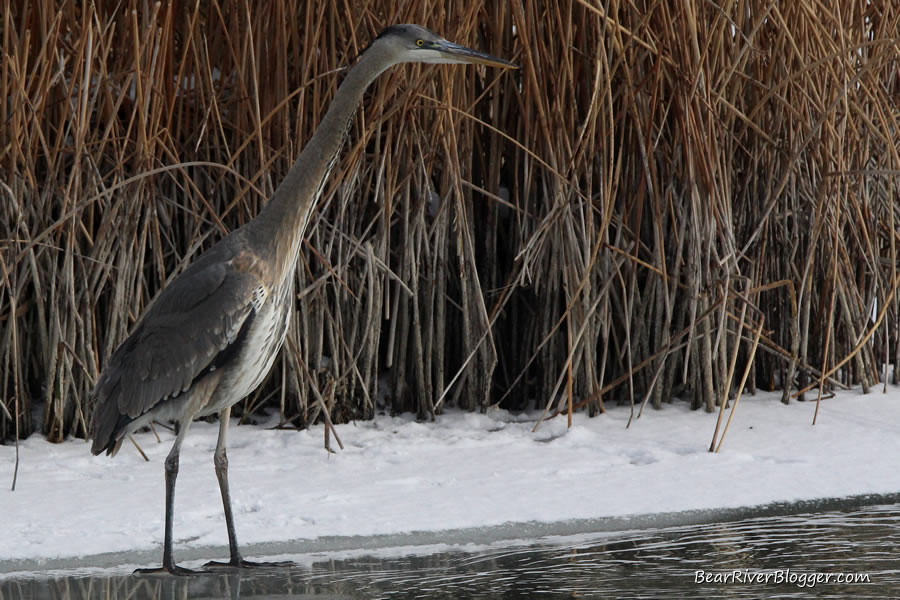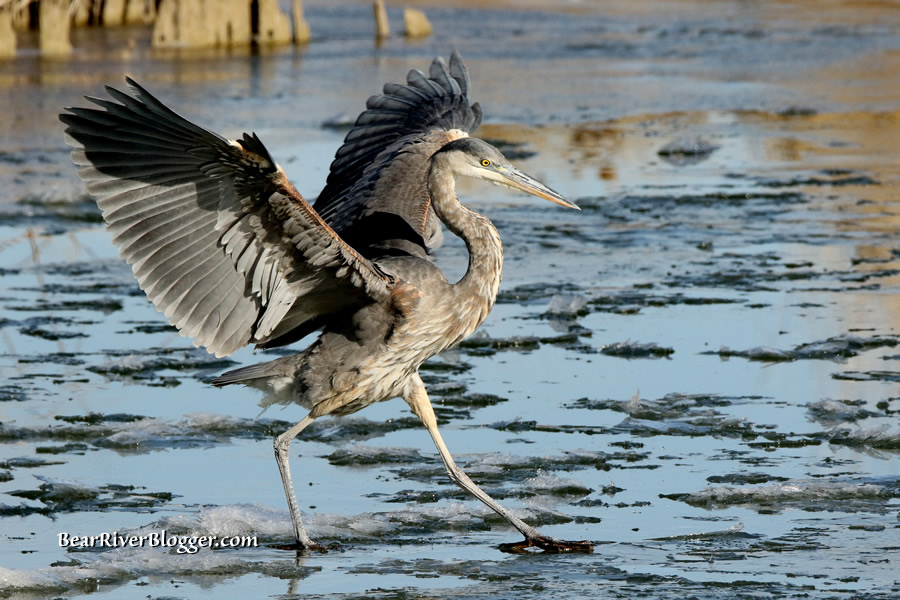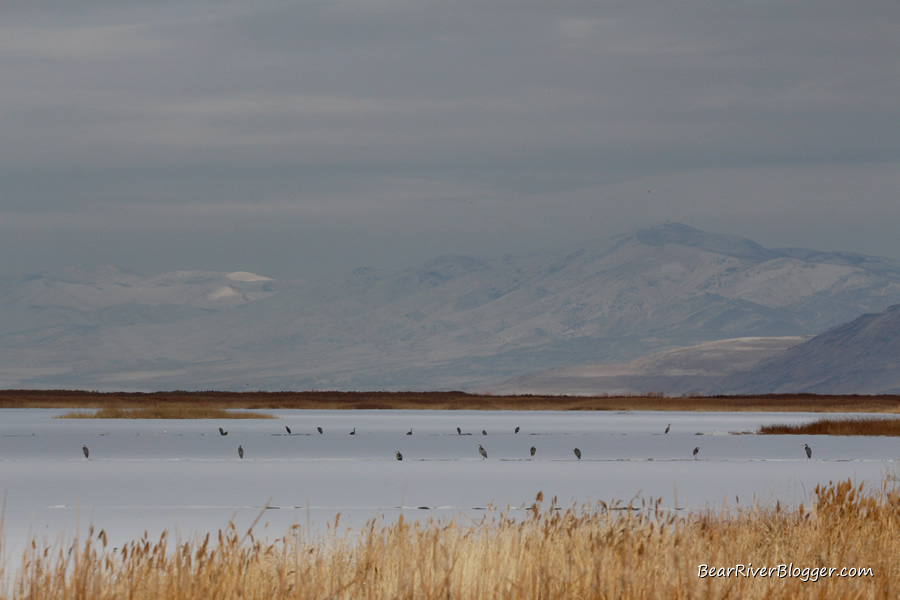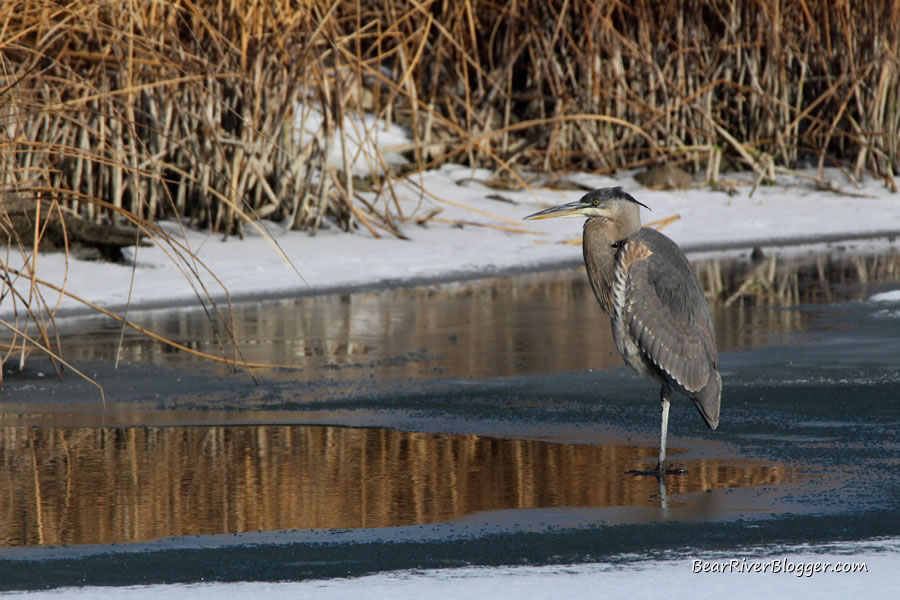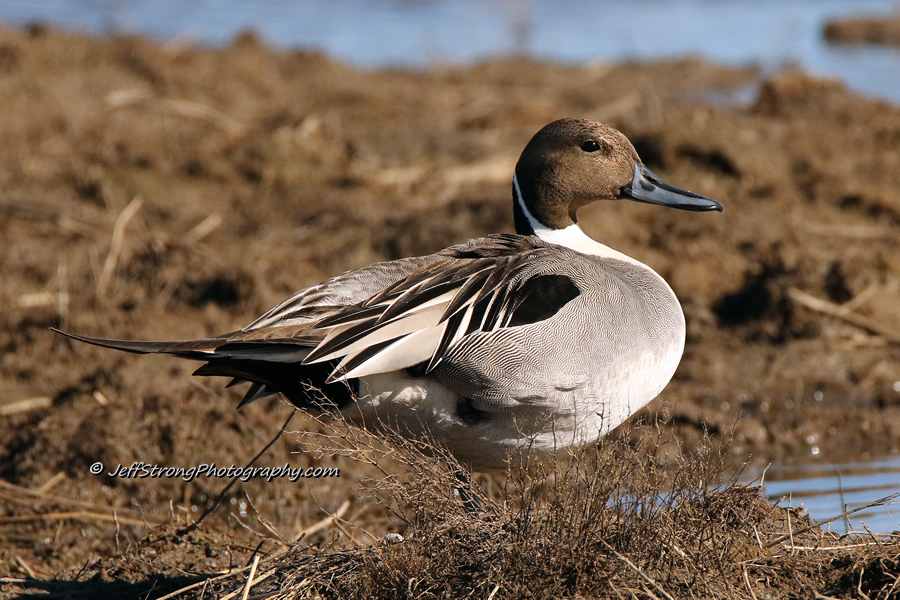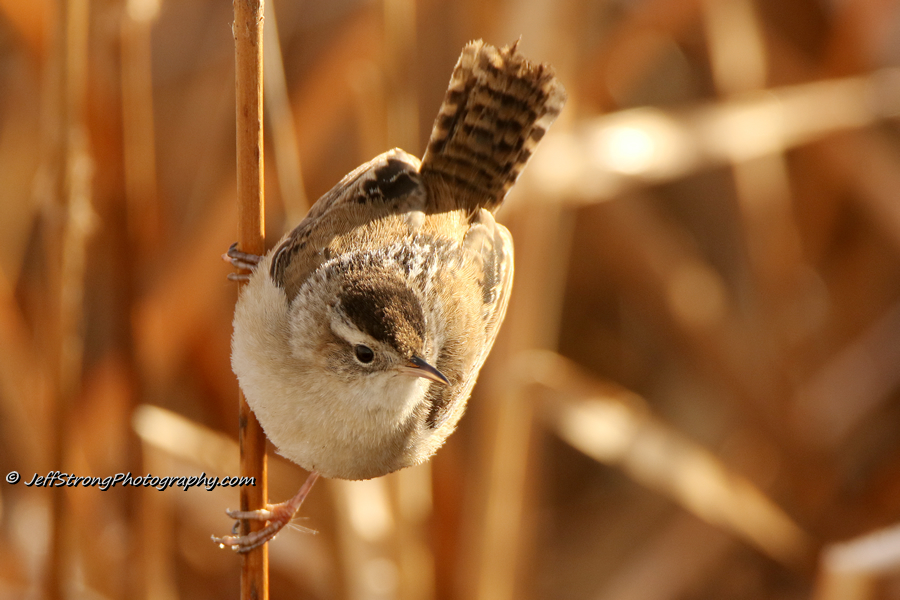If you were to ask me what is the best way to learn about birds, my suggestion to you would be, without any reservation, to simply get outdoors and just watch birds. Nature is, by far, the best teacher of the natural world around us, and all we have to do is go outside, pay attention, and observe.
A case in point about this very idea is a lesson I re-learned today while photographing great blue herons at the Bear River Migratory Bird Refuge on this cold winter’s day.
I came across a situation that plays out in nature on this particular bird refuge each and every winter, one that taught me a couple winters ago, in fact, how great blue herons can adapt to such frigid, harsh winters without migrating.
One of the more fascinating scenes in winter, at least for me, that is, are great blue herons hunched over small holes in the ice, patiently waiting for an unsuspecting fish to swim by below.
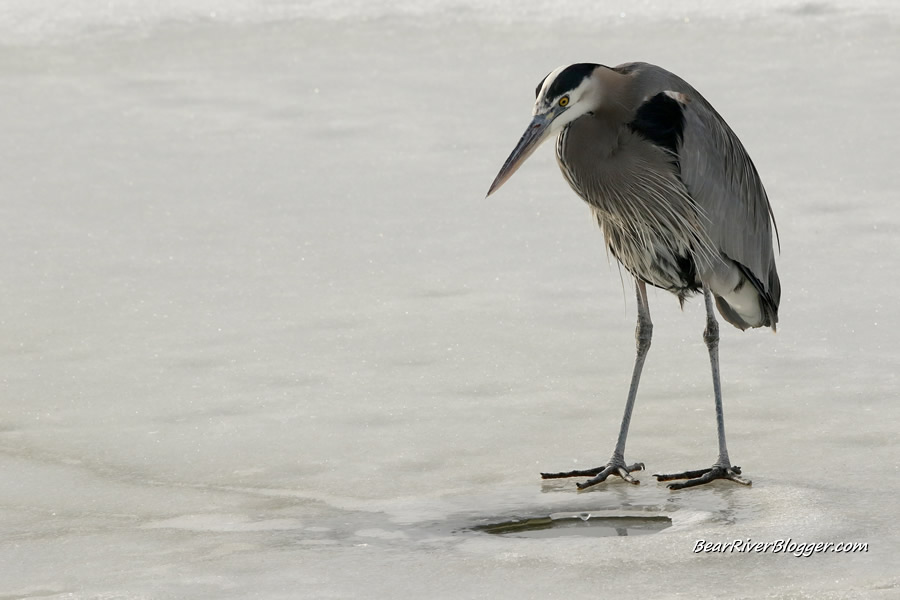
For hours, if needed, these stealthy birds will wait, and wait, and wait, while hardly moving a muscle, until it’s time to thrust its head into the icy water after a fish. They are the true definition of being an ice-fisherman, without a doubt.
Today, as I arrived at the Bear River Bird Refuge auto tour route, a lone great blue heron was doing just that, patiently standing on the edge of the ice on one of the few pockets of open water left on the river.
It’s a scene I have photographed countless times before during many previous winters on the refuge, except this time, however, I was excited to see the blue heron had some familiar company.
What I believe to be a first-year male common golden-eye duck was also hanging around this small patch of open but frigid river water. It’s quite possibly one of the oddest of all inter-species relationships in the bird world, for sure.

But, bear with me for a minute here, there is a distinct and important connection between these two birds, and it is why I get excited when I see them together, sharing such small yet icy quarters.
On the surface, the two birds seemed to not pay any attention to one another, but, however, things are not always as they appear, even in the bird world.
Motionless, the great blue heron stood at his post along the jagged edge of the icy water, patiently waiting for an unsuspecting fish to swim by. Occasionally, from diving under the water’s surface, the small brown duck would vanish for a moment or two as he searched the river bottom for a quick meal for itself.
Each bird was seemingly tending to its own daily business, searching for food without any concern for the other.
I wasn’t aware of this until I came across this exact scene in this exact place a couple years ago, but common golden-eye ducks do, in fact, eat small fish. They are a diver-type of waterfowl, meaning they can dive deep under the water and swim for a bit in search of food, including small fish.
This young duck was doing just that, and several times he came to the surface with a tiny fish in his beak.
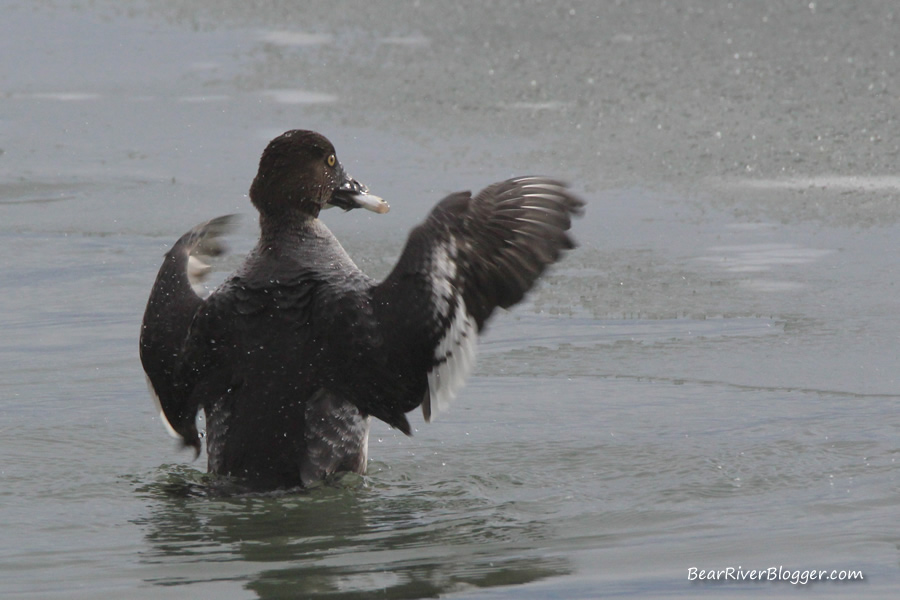
I wasn’t the only one that noticed his catches, however. Each time the duck surfaced with a fish, the hungry great blue heron would rush towards and lunge at the small duck, sometimes causing it to drop its meal and allowing the much larger, very intimidating heron to quickly gobble up the fish.
This wasn’t a rarity or a one-time thing, mind you. I have seen great blue herons scavenge for fish from common golden-eye ducks like this for several years now, and it seems to be how some of them have adapted to such harsh environments without migrating.
Each and every time, in fact, when I see a great blue heron and a common golden-eye together during winter in a small pocket of open water like this, I see this same battle of wits played out over and over again.
Sometimes, the heron wins, and, well, other times, the golden-eye wins, but it is a relationship in nature I never would have known or even considered if I hadn’t stopped to watch it a few years ago.

Great blue herons are fascinating birds and one of the more common birds found on the Bear River Migratory Bird Refuge during the dreads of winter. If you sit and watch a great blue heron for a while, you will learn how these primarily fish-eating birds can survive in such cold climates when many other birds have migrated south.
Where do great blue herons go in the winter?
Depending on the region, some populations of great blue herons migrate south for the winter, and some don’t.
Researchers believe only the more northern populations of great blue herons that reside east of the Rocky Mountains migrate south for the winter, flying as far as Central America, the Caribbean, or as far as the northern portion of South America.
Researchers also believe great blue herons west of the Rockies, even as far north as the Alaska coastline, don’t migrate at all but stay put. These western great blue herons will move around their home range during winter in search of open water and food when needed, but they don’t fly south for the winter.

I see this first-hand on the Bear River Migratory Bird Refuge with each passing year. Even during some of the coldest, wettest winters we have had here in Northern Utah, I have seen great blue herons on the refuge all winter long, or, in some years, fly short distances to surrounding areas in search of open water on the Bear River itself.
What do great blue herons eat in the winter?
During winters where waters freeze, a great blue heron will primarily still eat fish when small pockets of water are available to fish from, but they will also eat rodents and small birds when the opportunities arise during winter.
During some of the coldest, most frigid winters here on the refuge, I have witnessed great blue herons standing over small pockets of water, wherever they can be found and no matter how small they may be.

Sometimes, a small current of water going through a head-gate, for example, is enough movement to keep a little pocket of open water to persist during winter, and great blue herons will stand at these tiny holes in the ice for hours, if needed, for the opportunity to catch a fish.
How does a great blue heron adapt to its environment?
Great blue herons have a highly variable diet, which allows them to adapt to almost any environment, even areas where the waters freeze during the winter. When fish is hard to catch or is in short supply, great blue herons adapt and can hunt for reptiles, turtles, snakes, rodents, small birds, and even insects.
This highly variable diet allows the great blue heron to adapt to cold winters without migrating where other heron species and fish-eating birds need to fly south for the winter to find open water.
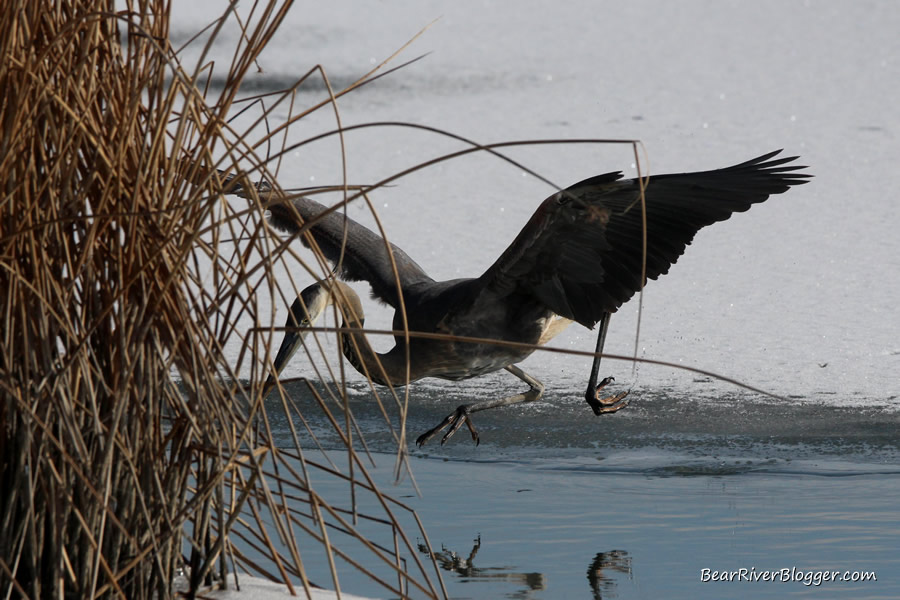
Great blue herons are solitary feeders, almost always seen spending their time alone quietly stalking shallow waters in search of food. Even in areas where numerous blue herons are found, individual great blue herons will oftentimes chase off other competing blue herons.
During winter, loose flocks of great blue herons can be found congregating around open pockets of water, but generally, these birds hunt and feed alone.
Conclusion
Great blue herons are fascinating birds to watch and photograph, especially during winter. I spend countless hours on the Bear River Migratory Bird Refuge each winter, looking for and observing blue herons standing over small ice holes or pockets of open water in hopes of catching a fish.
Great blue herons can adapt and eat other animals, such as rodents, small birds, and snakes, for example, but the heron primarily eats fish and will stand for hours in shallow water, if needed, to catch a meal for itself.
Getting out in nature and watching birds, such as the great blue heron during winter, is a great way to learn about birds. It’s how I realized the great blue heron will scavenge fish from the common golden-eye when the opportunity arises. I have seen it many times over, and I am certain I will see it countless times more in the future.
Subscribe to our blog
We appreciate your readership and suggest if you like this blog to head over to our subscription page and sign up for email notifications for future blog posts.
Great blue heron during winter images

